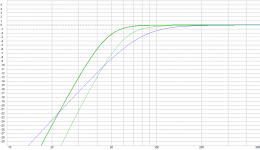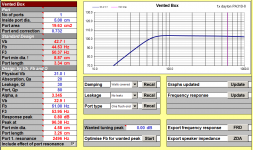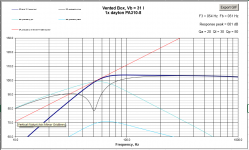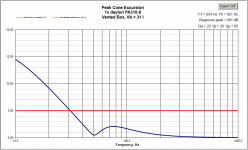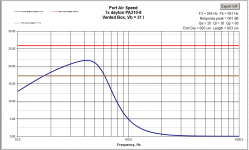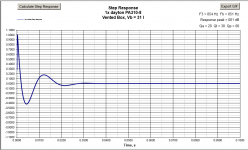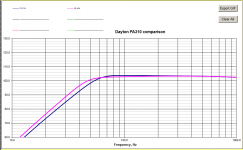Wanting opinions on weighing the credibility of DATS V3 measurements compared to the manufacturers. I realize this might be a silly question, as I bought the DATS so that I could get specs for the specific drivers I am using, I guess I just don't like what I am getting (because I wanted the smaller enclosure implied by posted specs)
I am working on making a version of Zilch's Econowave SR Compact, except I will be setting up an active crossover/amp unit that will let them travel in a small(ish) package. These will not by run with a sub, and ultimate performance in this area is not critical.
Woofer: Dayton Audio PA310-8
Average measured T/S between the two drivers I have
SPL: 93.1
Re: 6.07
Fs: 33.2
Qts: 0.2935
Qes: 0.3049
Qms: 7.816
Le: 0.4852
Mms: 83.73
Vas: 110.43
Manufacture's T/S
SPL: 96.1
Re: 5.5
Fs: 39
Qts: 0.29
Qes: 0.30
Qms: 8.85
Le: 1.68 (I have found many references to these speakers measuring lower Le than this spec)
Mms: 72.8
Vas: 91.8
When working in winisd, I have been comparing with the same quasi-butterworth alignment.
The predetermined ported boxes are:
Measured specs: 1.62 cuft / 41.3 Hz tune
Manufacturer's specs: 1.1 cuft / 51.7 Hz tune
While the extra performance down low is nice, the 50% increase in box size really isn't what I wanted to see. I can certainly shrink the box down, but the port gets really long and the first port resonance really low . . . which isn't ideal . . . If I raise the tune to increase the first port resonance a bit, a definite hump in the low end response begins to show up.
When is first port resonance objectionable? I could just EQ out the hump in the Bass.
If size is pretty important, I though about maybe giving up the port but that puts F3 at 80Hz. I will be using an ADA1701 for the crossovers, and will have access to the "SuperBass" algorithm, so I can cheat here a bit . . . but I can use this with ported too.
Am I right to rely on the DATS measurements and just try to get the best out of what I have, or should I be wondering if the manufacturer is better at measuring than me?
In the attached screen cap of transfer functions, from left to right:
ported using measured T/S
ported using Manufacturer's T/S
Sealed using measured T/S
I am working on making a version of Zilch's Econowave SR Compact, except I will be setting up an active crossover/amp unit that will let them travel in a small(ish) package. These will not by run with a sub, and ultimate performance in this area is not critical.
Woofer: Dayton Audio PA310-8
Average measured T/S between the two drivers I have
SPL: 93.1
Re: 6.07
Fs: 33.2
Qts: 0.2935
Qes: 0.3049
Qms: 7.816
Le: 0.4852
Mms: 83.73
Vas: 110.43
Manufacture's T/S
SPL: 96.1
Re: 5.5
Fs: 39
Qts: 0.29
Qes: 0.30
Qms: 8.85
Le: 1.68 (I have found many references to these speakers measuring lower Le than this spec)
Mms: 72.8
Vas: 91.8
When working in winisd, I have been comparing with the same quasi-butterworth alignment.
The predetermined ported boxes are:
Measured specs: 1.62 cuft / 41.3 Hz tune
Manufacturer's specs: 1.1 cuft / 51.7 Hz tune
While the extra performance down low is nice, the 50% increase in box size really isn't what I wanted to see. I can certainly shrink the box down, but the port gets really long and the first port resonance really low . . . which isn't ideal . . . If I raise the tune to increase the first port resonance a bit, a definite hump in the low end response begins to show up.
When is first port resonance objectionable? I could just EQ out the hump in the Bass.
If size is pretty important, I though about maybe giving up the port but that puts F3 at 80Hz. I will be using an ADA1701 for the crossovers, and will have access to the "SuperBass" algorithm, so I can cheat here a bit . . . but I can use this with ported too.
Am I right to rely on the DATS measurements and just try to get the best out of what I have, or should I be wondering if the manufacturer is better at measuring than me?
In the attached screen cap of transfer functions, from left to right:
ported using measured T/S
ported using Manufacturer's T/S
Sealed using measured T/S
Attachments
Your measurements are VERY close the the manufacturers with the exception of the le and a bit off on the VAS. Did you use added mass or volume method?
The final qts is almost identical. It's not at all uncommon for people to be posting their measured results being 20 - 50% off manufacturers specs so I think you are fine.
Are you sure you haven't made a mistake in your winisd sim? I just modeled your specs with a 31L box tuned to 51Hz and it is one of the best looking BR I've ever modeled. So good to make me wonder if something is wrong!
Tony.
The final qts is almost identical. It's not at all uncommon for people to be posting their measured results being 20 - 50% off manufacturers specs so I think you are fine.
Are you sure you haven't made a mistake in your winisd sim? I just modeled your specs with a 31L box tuned to 51Hz and it is one of the best looking BR I've ever modeled. So good to make me wonder if something is wrong!
Tony.
Attachments
Agreed, the variations aren't anything to stress over, for various underlying reasons. Have you considered running the driver for a while to loosen it up, then remeasuring? A few hours at highish excursion near resonance in free air might change things a little.
Are you sure you haven't made a mistake in your winisd sim?
Tony.
I went back into winisd parameters and changed the auto-calculated values . . . winisd calculates some values as you input others. The directions I have followed says not to change those calculated values.
With my measured values, it comes out to be 37.8L at 44 Hz. This is better, but now I wonder why there is a difference between out programs. Which are you using?
For reference, winisd calculated the following values that differ from my own
Cms: 0.2762
Qts: 0.314
Qes: 0.328
I don't have a measured Cms, but this value differs from the Dayton's at 0.23 . . . although changing it didn't seem to matter.
AllenB
I didn't state earlier, but these measurements were taken after 48 hrs of 20Hz.
T/S did change quite a bit over time (I check every 12hrs), but seemed to settle where they are now.
I didn't state earlier, but these measurements were taken after 48 hrs of 20Hz.
T/S did change quite a bit over time (I check every 12hrs), but seemed to settle where they are now.
I'm using unibox which is an excell spreadsheet. Note I ignored what unibox said (it recommended 42L and 44Hz tuning, and put in what you had as the factory recommended box. That is what I posted, and to me it looks very good.
If you use four different box programs, you will most likely get four different recommendations 🙂 whilst there are various recommended alignments, you don't have to be bang on one or another to get something workable.
Tony.
If you use four different box programs, you will most likely get four different recommendations 🙂 whilst there are various recommended alignments, you don't have to be bang on one or another to get something workable.
Tony.
As far as "factory recommended box," that was the winisd specified configuration for quasi-butterworth using the manufacturer provided specs. On parts-express website they actually state 29.5L with F3 at 73 Hz (No exact tuning listed, but it seems high). They used BassBox6 Pro . . . which to your point, yet another option from another program.
I realize I can change the transfer function around, I was just keeping the alignments the same to see how things were changing for a given rollofff.
Overall I think they look good as well, I will probably end on some middle ground solution, and then let the EQ in the crossover handle the rest if needed.
Thanks for the input!
I realize I can change the transfer function around, I was just keeping the alignments the same to see how things were changing for a given rollofff.
Overall I think they look good as well, I will probably end on some middle ground solution, and then let the EQ in the crossover handle the rest if needed.
Thanks for the input!
Here is a comparison between the alignment recommended by unibox and the factory manufacturer recommendation. The factory one being the darker one. Obviously the recommended one is more extended, but if you want to go with the smaller volume I don't see any issue with it at all.
edit: didn't refresh before posting 🙂 ok I think the winisd recommendation looks good with your measured specs, and it looks like this driver is well behaved over a range of alignments so yes do some experimenting and come up with something that suits your requirements 🙂
Tony.
edit: didn't refresh before posting 🙂 ok I think the winisd recommendation looks good with your measured specs, and it looks like this driver is well behaved over a range of alignments so yes do some experimenting and come up with something that suits your requirements 🙂
Tony.
Attachments
Last edited:
- Home
- Loudspeakers
- Multi-Way
- DATS vs Manufacturer
